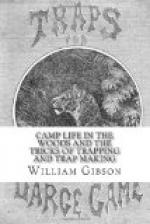This style of shelter is represented in our page title to this section, and certainly looks very comfortable.
TENTS.
Shanties like the foregoing are in general use among the old veteran trappers of all countries, and even to the amateur there is a charm in a shelter constructed from the rude materials of the woods which the portable tents do not possess.
Tents, however, are much used both by professionals and amateurs, and are indeed valuable acquisitions to the trapper’s outfit, and where time is valuable, do away with the labor which the construction of a hut or shanty involves.
Tents are of several kinds. Those most commonly used by the trapper are the house-tent, fly-tent, and half-tent, or shelter-tent.
The first of these is made for prop-poles and a ridge pole, closed on one end and buttoning up at the other. The sides are perpendicular for two or three feet, before the slope commences, and the stay-ropes are fastened to the eaves.
The fly-tent is generally a large, square piece of canvas, with ropes extending from opposite sides. This is thrown over a ridge pole, or over a rope extending between two trees, and the sides are held to the proper slope by tightening and pegging the side ropes to the ground. Fly-tents are also made with ends, which can be lowered, and the whole tent may be pegged close to the ground.
The shelter-tent, when erected, resembles, in general shape, the bark shanty already described. It consists of a strip of canvas, having each end cut off to a point. The tent is pitched over three slanting poles, and the ends are brought down and securely pegged. This is clearly shown in our illustration.
[Page 247] [Illustration]
We do not propose giving any extended directions for making tents, as they are a staple article of trade, and, as a general thing, can be bought for a figure which would render their domestic manufacture of little saving or profit. The shelter-tent, however, is so useful an affair, and withal so very simple made, that we will give a few directions in regard to its manufacture. It should be made from stout cotton drilling, or very heavy sheeting. Let the piece be about thirteen feet in length by six in width. Each end of the piece should now be cut to a rectangular point, commencing to cut at a distance of three feet from each corner. In order to render the cloth waterproof, it should now be dipped in a pail containing a solution of equal parts of alum and sugar of lead, a couple of handfuls of each, in tepid water. It should be allowed to remain several minutes in soak, being dipped and turned occasionally, after which it should be spread out to dry. This treatment not only renders the cloth impervious to rain, but the alum tends to make it fire-proof also. A spark from the fire falling upon a tent thus prepared, will often rest upon the cloth until it goes out, without doing the slightest damage.




